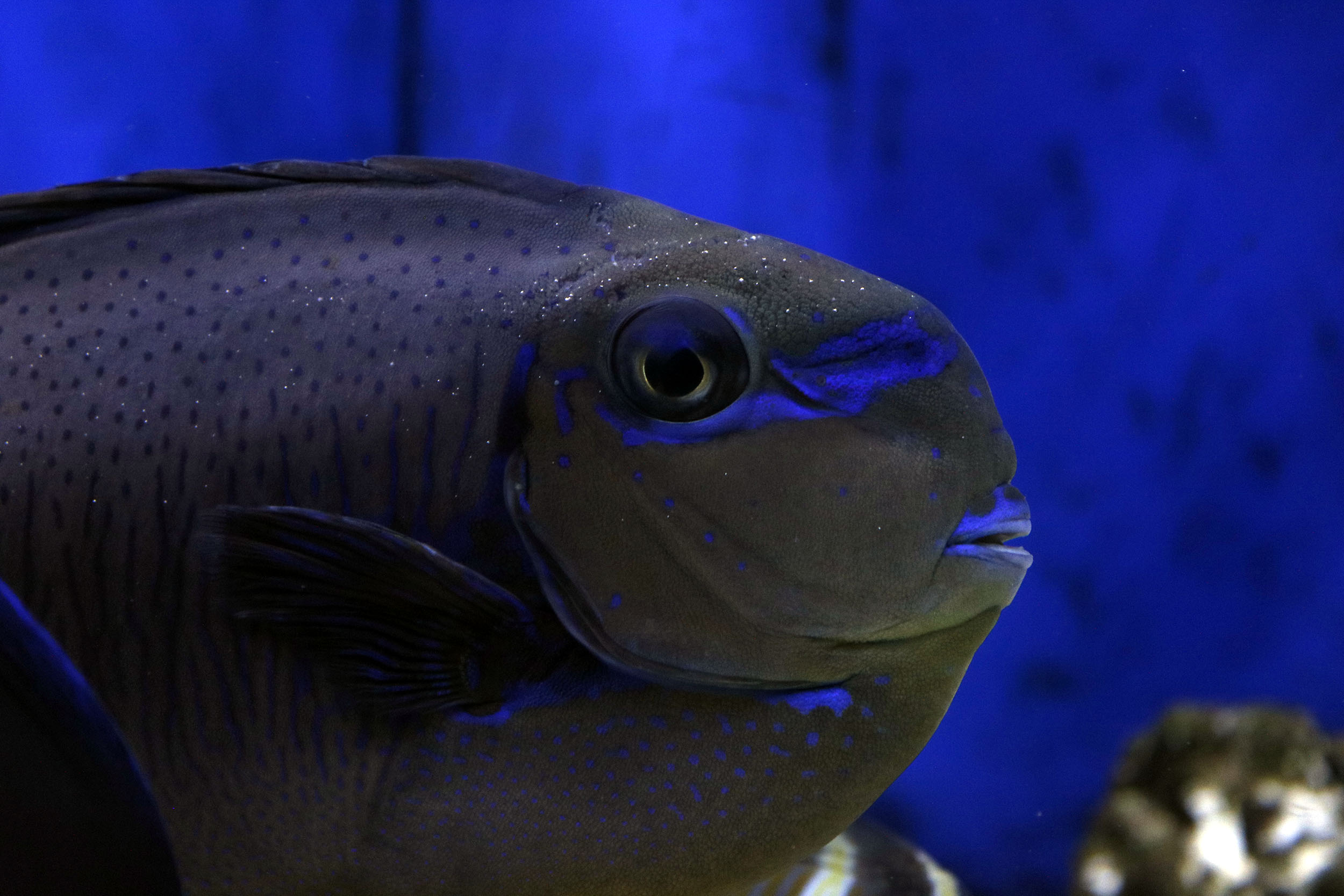Water quality issues, disease outbreaks and aggression among inhabitants plague The Reef’s aquarium. Above the tank hangs a plaque that reads, “Let this aquarium remind us of the importance of marine life to Florida and the Tampa Bay area.”
The 1,100-gallon saltwater aquarium was originally installed in 2013, funded by Duke Energy and Student Government and supplied by Secrets of the Sea Marine Exploration and Aquarium. The tank is now approaching its four-year anniversary.
Once housing over 30 fish, including two sharks, the aquarium’s population has dwindled to just 14 fish, few of which have lived in the tank since its original installation.
“It’s looking a little sad these days,” said Jim Greene, the USC facilities manager.
Zachary Ostroff is the curator for the Marine Discovery Center, formerly Secrets of the Sea Marine Exploration and Aquarium, and is the overseer of The Reef aquarium. Ostroff explained that the biggest issue the tank is facing is water quality.
“The ammonia in here gets pretty high.” said Ryanne Koerner, a sophomore marine biology student and one of two caretakers for the tank.

Ammonia and nitrite are considered toxic to fish. During the nitrogen cycle, ammonia and nitrite are broken down by beneficial bacteria into nitrate, which is less toxic to fish. However, without a proper nitrogen cycle, toxins can build up and become deadly.
In order to keep water chemistry levels safe, fish tanks require regular partial water changes. This is when a percentage of the tank’s current water is replaced with new water in order to remove toxins like nitrate. Without water changes, nutrients and toxins can build up and may cause things like excessive algae growth and water toxicity.
“The water can be kind of poisonous,” said Greene.
The tank has recently become the financial responsibility of the USC and now receives a portion of the USC’s budget. Currently, The Reef aquarium has a $5,000 service fee for supplies and maintenance duties like feeding, cleaning and water testing. The Reef aquarium shares its biweekly 16-18 designated hours with a 350-gallon tank in the College of Marine Science.
According to Koerner, about 10 out of the 16 hours are dedicated to The Reef aquarium. These hours are spent on daily feedings, weekly water tests and cleanings three times a week.
Currently, The Reef aquarium gets 200-250 gallon water changes every three to four months. According to curator Ostroff, these water changes should occur every month.
In order to perform a water change on The Reef aquarium, 200-250 gallons of saltwater must be shipped to the university. A series of hoses and pipes are used to get the new water in and old water out. The process is relatively expensive and time-consuming.
In an attempt to finally fix the water quality issues, the Marine Discovery Center will be installing a new system in the USC to provide monthly water changes. The new 250-gallon tank will be housed in a separate room near the restrooms. The new tank, which was purchased by Marine Discovery Center, will hold and prepare water that is suitable for water changes.
“My first concern is getting those water changes in and then maybe we can breathe some new life into it,” said Greene.
The poor water quality of the tank has led to persistent low-level diseases like ich. Ich is a common but potentially dangerous parasite found in both fresh and saltwater aquariums. Last year, there was an ich outbreak that contributed to the loss of several fish, including the last remaining puffer fish. In order to combat these diseases, curator Ostroff lowered the salinity levels to brackish conditions. This makes it very difficult for parasites like ich to survive, however they can become resistant.
“There is definitely still ich inside that aquarium,” said Joe Declet, co-owner of Fins and Skins. Declet has been providing aquatic maintenance for over 12 years. According to Declet, a $5,000 budget isn’t enough.
“The maintenance company is handcuffed by that budget,” said Declet.
The tank still has promise, though. Once the water chemistry is more suitable, new fish and possibly corals will be added. All fish and corals are supplied by Marine Discovery Center or donated to the tank. Other potential additions are an automatic feeder and reinstalling the feeding cameras and educational slideshow to teach students about the tank and its residents.
“This tank is here for education,” said Ostroff.
Ostroff and his team are still working to make The Reef aquarium a reminder of “the importance of marine life.”




At this point, I was the main aquarist in charge of maintaining this system. The reason the water quality was bad was because the aquarium maintenance company I worked for was supposed to receive a water tower, making it easy for water changes which is a crucial part of aquarium keeping. However, USFSP took forever to allow this tower to be implemented at the USC. Instead, we had to rent out a truck with a large 500gallon storage tank and unravel a hose from the USC parking lot (by the volleyball courts) all the way to the aquarium. This process was time consuming and expensive.
Also, USFSP provided an awfully low budget for the system’s maintenance. The company I was working for (Marine Exploration Center) couldn’t afford to pay me for more than 12hrs/wk. And keep in mind, I had two other 200 gallon systems to maintain. So I put in extra time with no pay to make sure the aquarium remained in good condition.
This article makes me look bad. It makes the Marine Exploration Center look bad. It makes my former supervisor look bad. When, in fact, it was USFSP and USC that neglected to provide a reasonable budget for the system’s maintenance. Shame on you.
Mr. Derosa,
Thanks for your feedback. I believe your explanation of the issue was relayed in the article as I discussed that water quality was an issue due to lack of water changes, and how water changes are currently performed (via shipping in water and using hoses.) I clearly stated that the tank was the financial responsibility of the USC and included a quote stating that the maintenance company was handcuffed by their budget. Throughout the article it also states how Marine Discovery Center is working to fix the issues and the reef aquarium receives the majority of man hours. While I would have loved to blatantly say that USFSP was completely to blame due to poor planning, my job is to relay information supported with the quotes provided by the interviewees. I spoke to 5 separate individuals and spent multiple weeks on this article trying to get in contact with other caretakers. I provided as many details as I could to allow the reader to reach their own conclusion.